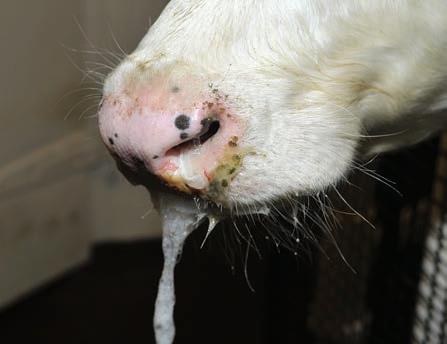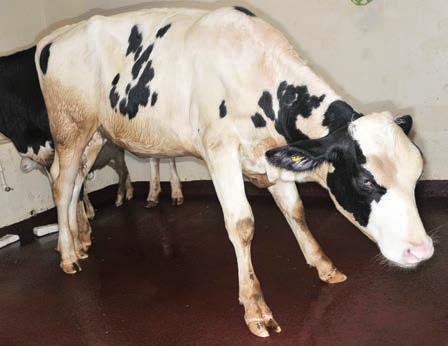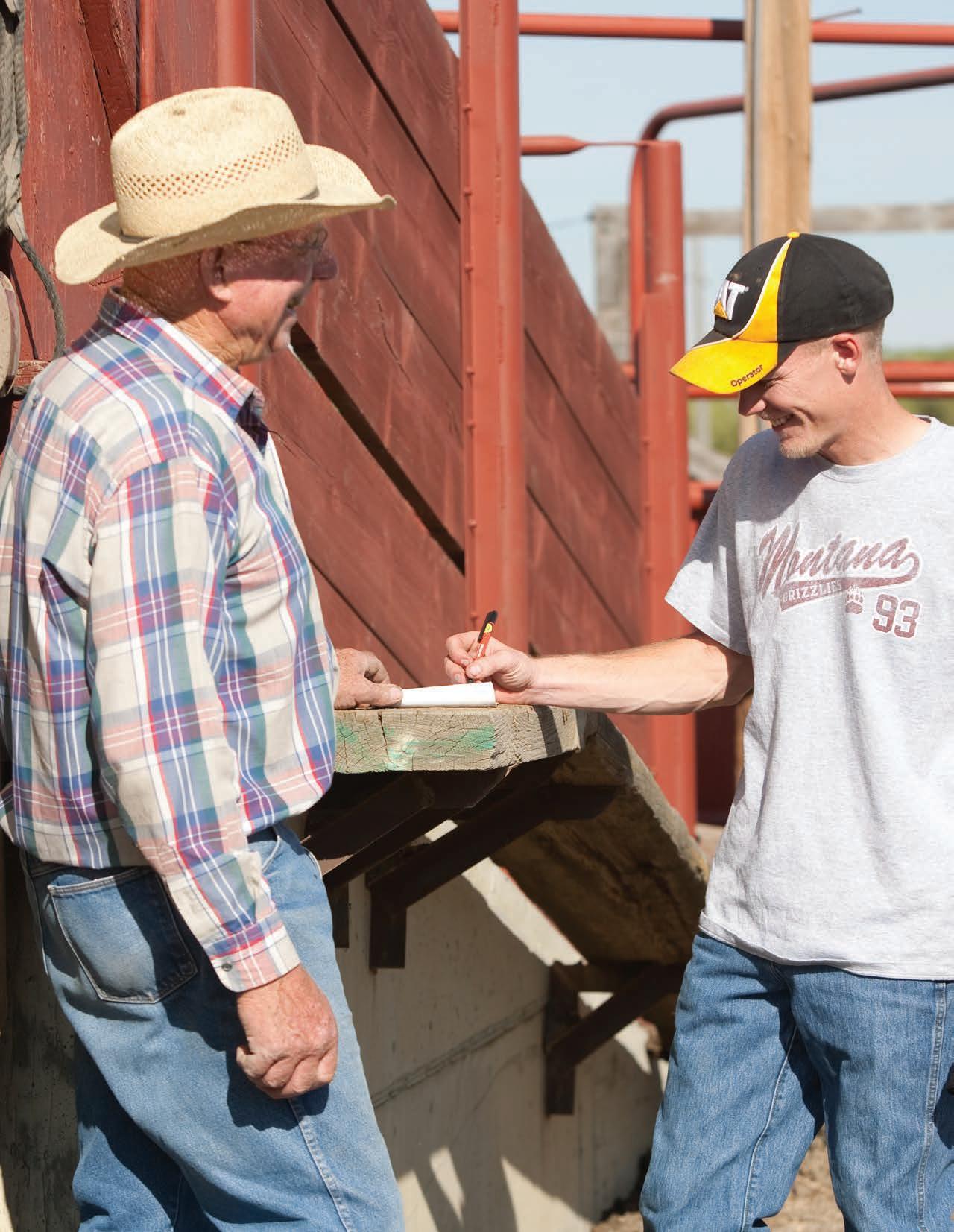
8 minute read
Chapter 6 — Biosecurity and Emergency Response
CHAPTER 6.
BIOSECURITY AND EMERGENCY RESPONSE
Advertisement
CHAPTER 6.1
INTRODUCTION
The goal of biosecurity is to protect animals from disease. This is accomplished through disease resistance and prevention as well as minimizing or controlling cross-contamination of bodily fluids. Cross contamination of body fluids can occur directly — animal to animal — or indirectly — animal to feed to animal or animal to equipment to animal. Biosecurity management practices aim to prevent the spread of disease by minimizing the movement of biological organisms such as viruses, bacteria, parasites, etc., in or on an operation. Biosecurity is more challenging for animals raised outdoors. However, leading management practices can reduce cattle's exposure to disease-causing agents.

6.2 Biosecurity Action Plan
Cattle diseases can cause substantial financial losses, and many of these diseases can be readily transmitted during transport. Transport places cattle in close proximity and trucks, trailers, equipment, and clothing and footwear can easily become contaminated with materials carrying pathogens, such as manure, respiratory secretions, urine, feces, and fomites. In the event of a biosecurity concern, follow these procedures to aid in containment of the disease, environmental contaminant, or intruder posing a threat to the health and well being of a livestock load. Critically assess each situation to determine the appropriate response steps. » All operations should have a biosecurity plan in place for daily operations. An example template can be found at www.bqa.org/ resources/templates-assessments. » Enhanced biosecurity plans will be necessary in the event of a Foot and Mouth Disease outbreak. More information including example templates can be found at securebeef.org.
PRACTICES FOR FARMERS, RANCHERS, AND PROFESSIONAL DRIVERS
» When you arrive to your operation, if possible, move and unload the new stock in a location where the rest of the existing herd is not in contact with the incoming cattle. » When unloading cattle, observe each animal for signs of sickness. If sickness is observed in an animal, they should be removed from the group to prevent the spread of disease. » Trailers and equipment, if used at another farm or operation, should be cleaned and disinfected before use or loading a new group of animals. » Non-employees or family that are helping should have clean clothing and boots prior to entering the operation to prevent entry of organic matter and potential infectious pathogens. » Provide gloves, over boots, coveralls, etc., if necessary. » Provide areas to clean and disinfect boots, hands, and equipment. » All persons assisting should be trained to use the equipment they are expected to use.
6.3 Biosecurity Awareness—Foreign Animal Disease Identification
As a transporter, you contribute a critical role in a safe food supply. Drivers and haulers can monitor for signs of foreign animal diseases (FADs) and act as a stopgap in the spread of FADs. FADs are important transmissible livestock diseases believed to be absent from the United States and its territories. FADs could have significant health or economic impacts on cattle and cattle operations. Preventing FAD outbreaks in our cattle industry is the responsibility of all sectors of the supply chain. Symptoms of typical diseases have been addressed in the Fitness for Transport chapter. The most concerning FAD in cattle is Foot and Mouth Disease (FMD). FMD is a very contagious viral disease of cloven-hooved (two-toed) animals. Common livestock affected include cattle, pigs, sheep, and goats. It has been eradicated from North America and there are many measures taken to prevent FMD from entering the country.
It is important to remember that FMD does NOT affect public health or food safety so both meat and milk are safe to eat and drink. Onset and severity of clinical signs will vary between animals. Cattle with FMD may exhibit one or more of the following signs: » Vesicular lesions (blisters, ulcers, and sores) • In the mouth—tongue, lips, dental pad, gums, muzzle/nostrils • On the hooves—around the coronary band (top of hoof) and between the toes of the hoof • On the teats—especially in lactating cows » Drooling » Loss of appetite » Lameness or reluctance to move » Nasal discharge » High fever Early recognition of FMD signs and prompt reporting are critical to containing this highly contagious disease. Drivers and haulers should immediately contact the operation’s manager to notify of them of these signs. The animals should not be loaded. The State Animal Health Official (SAHO) will be contacted by the farm or veterinarian and an investigation will start. If FMD enters the U.S., movements on and off farms could be stopped by State and Federal Officials to try and stop disease spread. FMD virus can spread on contaminated vehicles, equipment, even people’s clothing and footwear. In the event an FAD outbreak occurs in your area, the Federal Officials and the SAHO will likely request information that can be used to trace animals back to their farm of origin. Having accurate records of the movement of animals, vehicles, equipment, and people will be integral to the investigation. Once stopped, restarting movement will require a special permit issued by regulatory officials after the producer meets certain requirements, including enhanced biosecurity. These practices are part of the Secure Beef Supply Plan for Continuity of Business during an FMD Outbreak. Transporters are encouraged to understand the components of an enhanced biosecurity plan. The Secure Beef Supply (SBS) Plan provides guidance to producers and transporters who have cattle with no evidence of FMD infection prepare to meet movement permit requirements. Visit securebeef.org for more information.6
Foot lesions may cause animals to shift weight or spread out their front feet, be reluctant to move, and have a hunched back.7

DROOLING LAMENESS

Excessive salivation due to mouth lesions; nasal discharge.7
6 https://securebeef.org/Assets/SBS_FMDPocketGuide.pdf 7 USDA APHIS Foreign Animal Disease Diagnostic Laboratory and the U.S. Department of Homeland Security (DHS) Primus Visual Information
Services at the Plum Island Animal Disease Center (PIADC)
6.4 Emergency Response
First, assess the situation. If the situation appears to be life threatening for you, other bystanders, or the livestock on your trailer, request emergency medical or law enforcement assistance immediately.
ASSESSING THE SITUATION
» Is it a disease or health concern of one or more animals on your load? Watch for abnormal behavior such as foaming at the mouth or difficulty breathing. Contact your dispatch office or a state animal health official and they will contact the appropriate officials.
Wait for their instructions to proceed. » Is it an environmental contaminant concern?
If a contaminant is suspected, pinpoint the source and isolate it.
Set a safe perimeter around your load, taking » Set a safe perimeter around your load, taking necessary precautions to protect the safety of yourself, bystanders, and the livestock. Contact your dispatch office or local authorities and they will contact the appropriate officials. Wait for their instructions to proceed. » Is it an intruder concern? Be extremely cautious of strangers. DO NOT allow anyone access to your load.
PROCEDURES FOR RESPONDING TO EMERGENCIES
» In the event of an emergency, contact the local law enforcement agency and describe your location, the nature of the emergency, and include the information about your load. » Develop a list of people to contact in the case of an emergency. See below. » Organize names, phone numbers, and contact information ahead of time so you have quick access to them in the case of an
emergency. » Determine a list of alternative delivery location(s) if the cattle are in transit and the load needs to be canceled or rerouted. » DO NOT discuss details about your load with strangers or the media. Be cautious about allowing pictures or videos.

6.5 Emergency Action Planning
Emergency action plans are critical for an operation’s ability to address a variety of infrequent but often dangerous situations. Emergency action plans should be available at critical access points where you, your crew, or others can find and use it to contact help. A copy should also be available in remote locations and in the glove compartment of vehicles. Review your action plan with your crew on a regular basis and update it when changes are required. Emergency action plans should contain: » Premises Name » Premises ID Number (PIN) » Owner Name and/or Operator Name » Farm Services Agency (FSA) Number » GPS Coordinates » Site Physical Address (911 Address) » Directions to the Site from Nearest Town(s) » Important telephone numbers • 9-1-1 • Operation Owner • Herd Manager • Cattle Handlers • Veterinarian • Local Doctor’s Office • Local Emergency Room • Local Poison Control • Local Fire Department(s) • Local Police Department(s) • State Police • Sheriff • Highway Patrol • Electric Company • Water Company • Natural Gas Company • Telecommunications/Internet
FOREIGN ANIMAL DISEASE EMERGENCIES
Operations that suspect FAD in an animal or herd should call the USDA APHIS Assistant Director (AD) for your state or your State Animal Health Official (SAHO). Contact information for your AD or SAHO can be obtained by calling (866) 536-7593. You can also call the USDA Emergency number (800) 940-6524 (24 hours) for assistance. Information will be kept confidential during the investigation.
TRANSPORTATION EMERGENCIES
» Engage all employees that transport livestock in the BQAT Program; they can participate online at BQA.org or through an in-person program. » Encourage local first responders to participate in the Bovine Emergency Response Plan (BERP). » Consider conducting a mock emergency to practice the chain of phone calls or practice responding to a stranded trailer loaded with cattle. » Consider who will administer euthanasia and how if it becomes necessary due to a transportation emergency.
National Cattlemen’s Beef Association 9110 E. Nichols Avenue, Suite 300 • Centennial, Colorado 80112 303.694.0305 • BQA.org






